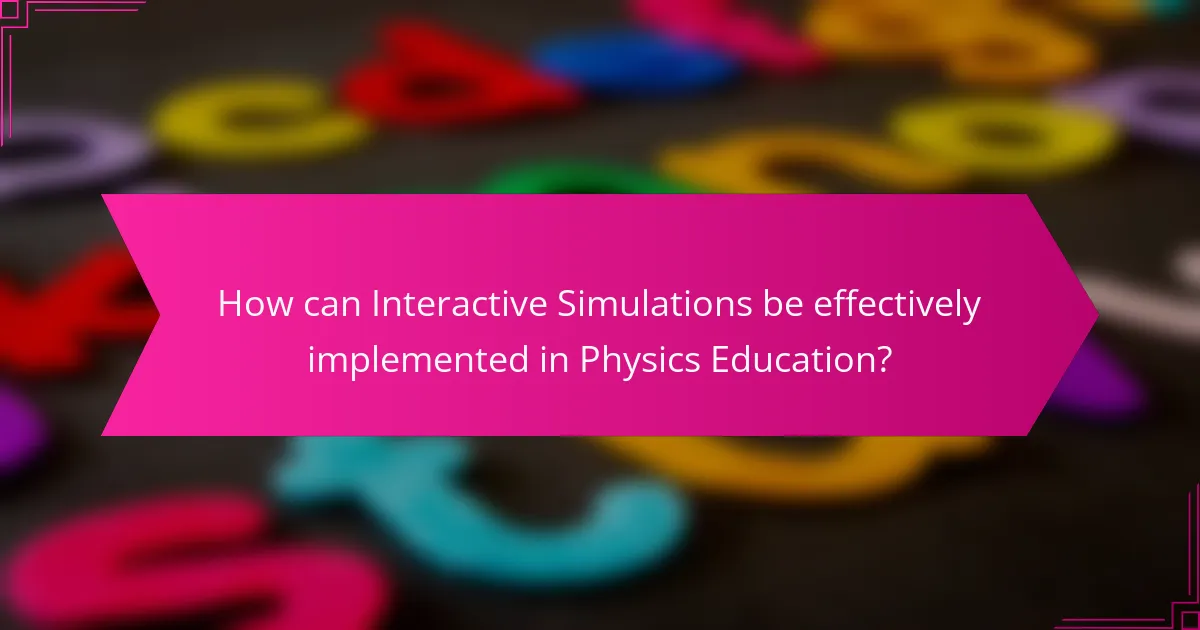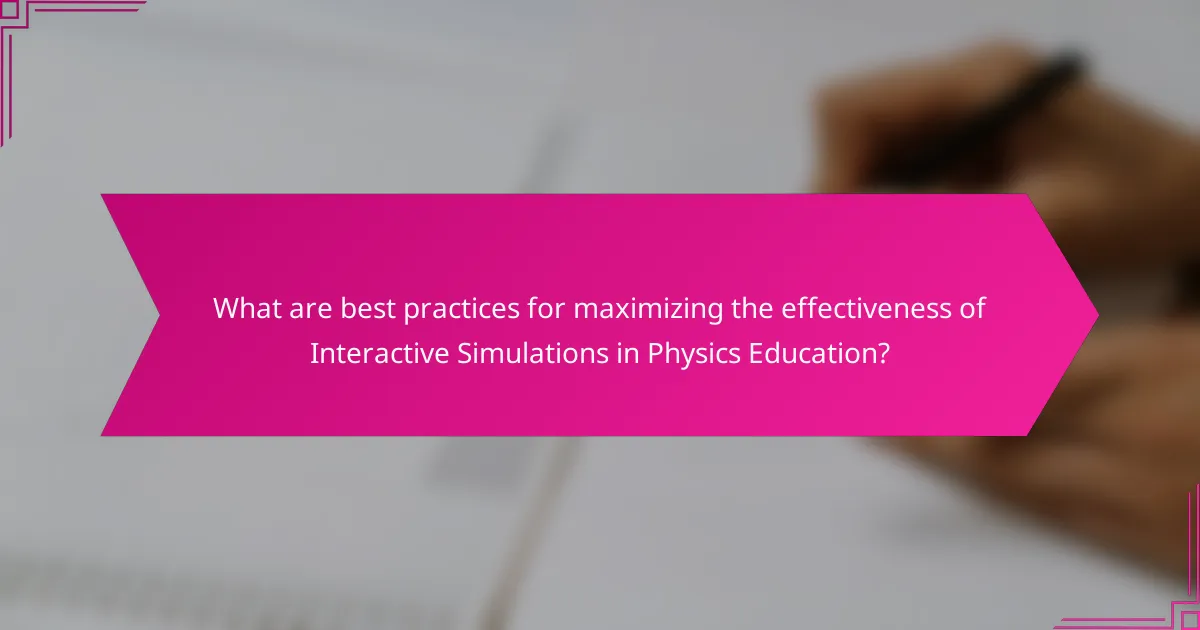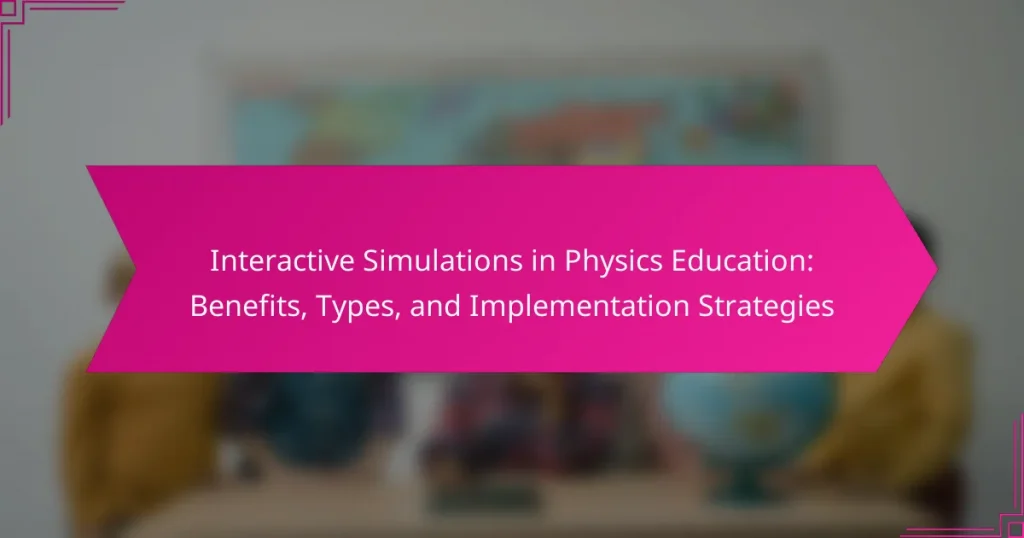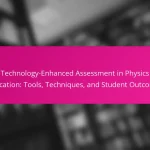Interactive simulations in physics education are digital tools designed to enhance student engagement with physics concepts through interactive experiences. These simulations enable visualization and manipulation of physical phenomena, providing real-time feedback and opportunities for experimentation without physical constraints. Research indicates that students using these simulations demonstrate improved understanding and retention of complex topics, often outperforming peers reliant on traditional teaching methods. Effective implementation of simulations involves aligning them with specific learning objectives, fostering active participation, and integrating assessments to gauge comprehension. Best practices include facilitating collaborative learning, providing immediate feedback, and regularly updating simulations to maintain relevance and effectiveness in the curriculum.

What are Interactive Simulations in Physics Education?
Interactive simulations in physics education are digital tools that allow students to engage with physics concepts through interactive experiences. These simulations enable learners to visualize and manipulate physical phenomena in a virtual environment. They often incorporate real-time feedback and allow for experimentation without the constraints of physical resources. Research shows that interactive simulations can enhance understanding and retention of complex topics. For example, a study by the University of Illinois found that students using simulations scored significantly higher on assessments compared to those who relied solely on traditional teaching methods. These tools bridge the gap between theory and practical application in physics learning.
How do Interactive Simulations enhance learning in Physics?
Interactive simulations enhance learning in physics by providing immersive, hands-on experiences. These simulations allow students to visualize complex concepts and phenomena. They can manipulate variables and observe outcomes in real-time. This interactivity promotes deeper understanding and retention of material. Research shows that students engaged with simulations perform better in assessments. A study by Wieman et al. (2010) found that interactive simulations improved conceptual understanding in physics courses. Additionally, simulations cater to diverse learning styles, making physics more accessible to all students. Overall, interactive simulations are effective tools for enhancing physics education.
What cognitive benefits do students gain from using Interactive Simulations?
Students gain enhanced cognitive benefits from using interactive simulations. These benefits include improved problem-solving skills, better conceptual understanding, and increased engagement. Interactive simulations allow students to visualize complex physics concepts in a dynamic environment. This visualization aids in retention and comprehension of abstract ideas. Research shows that students using simulations perform better on assessments compared to those who do not. For example, a study published in the Journal of Educational Psychology found that students using interactive simulations scored 20% higher on tests measuring conceptual understanding. Additionally, simulations encourage active learning, fostering critical thinking skills as students manipulate variables and observe outcomes.
How do Interactive Simulations cater to different learning styles?
Interactive simulations cater to different learning styles by providing varied modalities for engagement. Visual learners benefit from graphical representations and animations. Auditory learners gain from narrated explanations and sound effects. Kinesthetic learners engage through interactive manipulation of objects within the simulation. These features accommodate diverse preferences, enhancing understanding and retention. Research indicates that simulations can improve learning outcomes across various styles. A study by Limniou and Smith (2010) found that students using interactive simulations showed better conceptual understanding in physics compared to traditional methods. This versatility makes interactive simulations effective tools in education.
What types of Interactive Simulations are available in Physics Education?
Types of interactive simulations available in physics education include virtual labs, 3D visualizations, and online interactive tutorials. Virtual labs allow students to conduct experiments in a simulated environment. 3D visualizations help illustrate complex concepts like electromagnetic fields or atomic structures. Online interactive tutorials provide step-by-step guidance on various physics topics. These simulations enhance understanding by allowing hands-on experience and visual learning. They are widely used in educational institutions to improve student engagement and comprehension in physics.
What are the key categories of Interactive Simulations?
The key categories of interactive simulations include virtual labs, game-based simulations, and scenario-based simulations. Virtual labs allow students to conduct experiments in a digital environment. Game-based simulations engage learners through interactive challenges and rewards. Scenario-based simulations present real-world situations for problem-solving practice. Each category enhances understanding of physics concepts through active participation. These simulations have been shown to improve learning outcomes in educational settings.
How do different types of simulations target specific physics concepts?
Different types of simulations target specific physics concepts by creating interactive environments that illustrate fundamental principles. For example, kinematic simulations demonstrate motion through graphs and animations. These simulations allow students to visualize concepts like velocity and acceleration in real-time.
Electromagnetic simulations illustrate electric fields and forces through interactive charge distributions. Students can manipulate variables to see direct effects on field strength and direction.
Thermodynamic simulations model heat transfer and phase changes, allowing learners to experiment with temperature and pressure. This hands-on approach reinforces understanding of laws like conservation of energy.
Each simulation type focuses on distinct physics concepts, enhancing comprehension through practical application and visual representation.
What are the key benefits of using Interactive Simulations in Physics Education?
Interactive simulations in physics education enhance learning by providing engaging, hands-on experiences. They allow students to visualize complex concepts, making abstract theories more concrete. Research shows that students who use interactive simulations demonstrate improved understanding and retention of material. For instance, a study published in the “American Journal of Physics” found that students using simulations scored significantly higher on assessments. These tools also promote active learning, encouraging students to experiment and explore scenarios at their own pace. Furthermore, interactive simulations can cater to diverse learning styles, making physics more accessible to all students. Overall, they foster a deeper comprehension of physics principles and improve academic performance.
How do Interactive Simulations improve student engagement?
Interactive simulations improve student engagement by providing immersive, hands-on learning experiences. These simulations allow students to experiment with concepts in a virtual environment. This interactivity fosters curiosity and encourages active participation. Research shows that students retain information better when they engage with content actively. A study by the University of California found that interactive simulations can increase student understanding by up to 30%. Additionally, simulations offer immediate feedback, helping students correct misconceptions in real-time. This instant validation enhances motivation and keeps students focused. Overall, interactive simulations create a dynamic learning atmosphere that promotes deeper engagement.
What impact do Interactive Simulations have on academic performance?
Interactive simulations positively impact academic performance. They enhance student engagement and motivation. Research shows that students using interactive simulations score higher on assessments. A study by Wieman et al. (2010) found that interactive simulations improved conceptual understanding in physics. Students demonstrated better problem-solving skills when using these tools. Additionally, simulations provide immediate feedback, allowing for real-time learning adjustments. This interactive approach fosters a deeper understanding of complex concepts. Overall, interactive simulations contribute to improved academic outcomes in physics education.

How can Interactive Simulations be effectively implemented in Physics Education?
Interactive simulations can be effectively implemented in physics education by integrating them into the curriculum. Teachers should align simulations with specific learning objectives. This ensures that each simulation serves a clear educational purpose.
Utilizing simulations allows students to visualize complex concepts. For example, simulations can demonstrate forces, motion, and energy transformations. This visual representation enhances understanding and retention.
Moreover, incorporating interactive elements encourages active participation. Students can manipulate variables and observe outcomes in real-time. This hands-on approach fosters critical thinking and problem-solving skills.
Training educators on effective simulation use is crucial. Professional development can help teachers integrate these tools seamlessly. Research shows that students engaged in interactive simulations perform better academically.
Incorporating assessments alongside simulations can further enhance learning. This allows educators to gauge student understanding and adjust instruction accordingly. Overall, a structured implementation strategy maximizes the benefits of interactive simulations in physics education.
What strategies can educators use to integrate Interactive Simulations into their curriculum?
Educators can integrate Interactive Simulations into their curriculum by employing several strategies. First, they can align simulations with learning objectives. This ensures that the simulations support specific educational goals. Next, educators can incorporate simulations into lesson plans as interactive components. This promotes active learning and engagement among students.
Additionally, they can facilitate collaborative learning by allowing students to work in groups during simulations. This encourages discussion and teamwork. Educators should also provide guided instructions and context for each simulation. Clear explanations help students understand the purpose and application of the simulations.
Moreover, they can assess student understanding through follow-up discussions or assignments related to the simulations. This reinforces learning and provides feedback on student comprehension. Lastly, educators can continuously evaluate and adapt the use of simulations based on student performance and feedback. This ensures that the simulations remain effective and relevant.
How can teachers assess the effectiveness of Interactive Simulations?
Teachers can assess the effectiveness of interactive simulations through various methods. They can utilize pre- and post-assessments to measure students’ knowledge gains. Observations during simulation activities can provide insights into student engagement and understanding. Collecting student feedback through surveys can reveal their perceptions of the simulations. Analyzing performance data from the simulations can help identify areas of improvement. Additionally, comparing student performance in traditional versus simulation-based learning can provide concrete evidence of effectiveness. Research shows that interactive simulations can enhance learning outcomes in physics education, as demonstrated in studies like “The Role of Simulations in Physics Education” by Harlow et al. (2017).
What resources are available for educators to create or access Interactive Simulations?
Educators can access various resources to create or access interactive simulations. Platforms like PhET Interactive Simulations provide free, research-based simulations for teaching science and math. LabXchange offers virtual lab experiences and simulations for educators and students. Additionally, platforms such as GeoGebra allow users to create dynamic mathematics content, including simulations. Unity and Unreal Engine are powerful tools for developing custom interactive simulations. Furthermore, resources like the National Science Digital Library curate collections of interactive educational materials. These resources are supported by research demonstrating their effectiveness in enhancing student engagement and understanding in physics education.
What challenges might educators face when implementing Interactive Simulations?
Educators may face several challenges when implementing interactive simulations. One significant challenge is the availability of technology. Many schools may lack the necessary hardware or software to run simulations effectively. Additionally, educators may need training to use these tools effectively. Without proper training, they may struggle to integrate simulations into their teaching. Another challenge is aligning simulations with curriculum standards. Educators must ensure that simulations meet educational goals and learning outcomes. Furthermore, there can be resistance from students who prefer traditional learning methods. Engaging students in simulations requires a shift in mindset. Lastly, the cost of high-quality simulations can be prohibitive for some institutions. Budget constraints may limit access to the best resources available.
How can technical issues with Interactive Simulations be resolved?
Technical issues with Interactive Simulations can be resolved through systematic troubleshooting and user support. First, users should check their internet connection and ensure it meets the simulation’s requirements. Next, updating the web browser or software used to access the simulation can resolve compatibility issues. Clearing the browser cache may also improve performance by removing outdated data. If the simulation still does not function properly, users should consult the help section or user manual for specific guidance. Additionally, contacting technical support can provide tailored assistance for unresolved issues. Many educational institutions also provide resources or forums where users can share solutions. Regular updates and maintenance of the simulation software are crucial for minimizing future technical problems.
What are common misconceptions about Interactive Simulations in education?
Common misconceptions about interactive simulations in education include the belief that they replace traditional teaching methods. In reality, simulations complement and enhance traditional learning. Another misconception is that they are only effective for visual learners. Research shows that interactive simulations benefit all learning styles by engaging students actively. Some people think that simulations are too complicated for students to use. However, many simulations are designed for ease of use and accessibility. There is also a belief that simulations provide a complete understanding of concepts. In fact, they are tools that require guidance and context from instructors to maximize their effectiveness. Lastly, some educators assume that simulations are only useful in specific subjects. Evidence indicates that interactive simulations can be applied across various disciplines, including physics, biology, and mathematics.

What are best practices for maximizing the effectiveness of Interactive Simulations in Physics Education?
Best practices for maximizing the effectiveness of interactive simulations in physics education include aligning simulations with learning objectives. This ensures that simulations directly support the curriculum. Involving students in active learning enhances their engagement and retention. Facilitating collaborative learning through group activities promotes discussion and deeper understanding. Providing immediate feedback during simulations helps students correct misconceptions. Encouraging reflection on simulation experiences fosters critical thinking. Integrating simulations with traditional teaching methods creates a balanced approach. Regularly updating simulations based on technological advancements maintains relevance and effectiveness. Research shows that these practices can significantly improve student outcomes in physics education.
How can educators design lessons that incorporate Interactive Simulations effectively?
Educators can design lessons that incorporate interactive simulations effectively by aligning simulations with learning objectives. They should first identify key concepts in physics that can be enhanced through simulation. Next, educators must select appropriate simulations that provide realistic scenarios for students to explore.
Incorporating guided inquiry within the simulations encourages critical thinking. Educators should also integrate assessments to measure understanding and engagement. Providing opportunities for collaborative work enhances peer learning during simulations.
Lastly, educators should gather feedback from students to refine the use of simulations in future lessons. Research shows that interactive simulations can improve student learning outcomes, as evidenced by a study published in the Journal of Science Education and Technology, which found that students using simulations scored significantly higher on assessments than those who did not.
What role does feedback play in the use of Interactive Simulations?
Feedback is crucial in interactive simulations as it enhances learning outcomes. It provides users with immediate responses to their actions, facilitating understanding of concepts. This real-time information helps learners identify mistakes and correct them promptly. Studies show that feedback in simulations can improve retention of knowledge by 20-30%. It also encourages engagement, as users feel more connected to the learning process. Furthermore, feedback fosters self-regulation, allowing learners to assess their performance and adjust their strategies. Overall, effective feedback in interactive simulations significantly contributes to a deeper comprehension of physics concepts.
How can collaboration among students enhance the use of Interactive Simulations?
Collaboration among students enhances the use of Interactive Simulations by fostering deeper engagement and understanding. When students work together, they can share diverse perspectives and problem-solving approaches. This teamwork encourages peer teaching, where students explain concepts to each other, reinforcing their own understanding. Research shows that collaborative learning improves critical thinking skills. Additionally, students can tackle complex simulations more effectively as a group. They can divide tasks based on individual strengths, leading to more efficient exploration of the simulation. A study by Johnson and Johnson (1999) found that collaborative learning increases achievement and retention in educational settings. Thus, collaboration significantly enriches the learning experience with Interactive Simulations.
What tips can educators follow to ensure successful implementation of Interactive Simulations?
Educators can ensure successful implementation of interactive simulations by integrating them into the curriculum effectively. First, they should align simulations with learning objectives. This ensures that the simulations serve a clear educational purpose. Second, educators must provide adequate training for both teachers and students. Familiarity with the tools enhances engagement and effectiveness. Third, they should encourage collaborative learning. Group activities foster discussion and deeper understanding among students. Fourth, continuous assessment is essential. Regular feedback helps educators gauge the effectiveness of the simulations. Finally, educators should adapt simulations based on student feedback. This responsiveness improves the learning experience. Research indicates that these strategies enhance student engagement and learning outcomes in physics education.
How can teachers encourage student reflection and discussion after using Interactive Simulations?
Teachers can encourage student reflection and discussion after using interactive simulations by implementing structured debriefing sessions. These sessions should include open-ended questions that prompt students to analyze their experiences. For example, teachers can ask students what they learned and how it relates to real-world applications. Small group discussions can facilitate deeper conversations and allow students to share diverse perspectives. Incorporating reflective journals can also help students articulate their thoughts and feelings about the simulation. Research indicates that reflective practices enhance critical thinking skills and retention of concepts. According to a study by Harlow et al. (2022), structured reflection significantly improved student engagement in science education.
What ongoing support and training should educators seek for effective use of Interactive Simulations?
Educators should seek ongoing professional development focused on interactive simulations. Training programs should include workshops on simulation software and pedagogical strategies. Regular access to online resources and communities is essential for sharing best practices. Collaboration with peers can enhance understanding and application of simulations. Continuous feedback from students can guide improvements in instructional methods. Research indicates that educators who engage in sustained training show increased effectiveness in using simulations. Studies highlight that professional development leads to better student outcomes in physics education.
Interactive simulations in physics education are digital tools that facilitate student engagement with physics concepts through interactive experiences. This article covers the benefits of interactive simulations, including enhanced learning, cognitive gains, and improved academic performance. It discusses various types of simulations, such as virtual labs and scenario-based simulations, and outlines effective implementation strategies for educators. Additionally, the article addresses challenges and best practices for integrating these tools into the curriculum, emphasizing the importance of feedback and collaboration among students.


